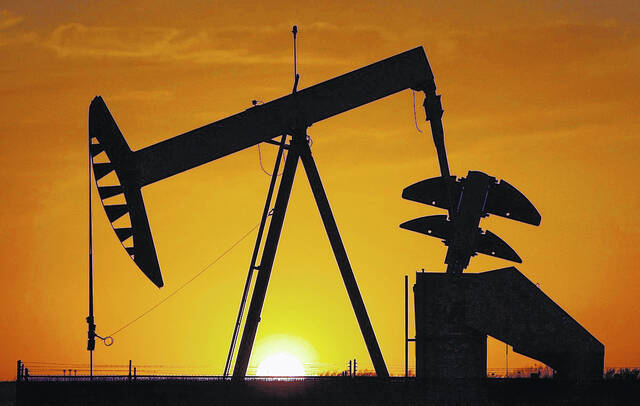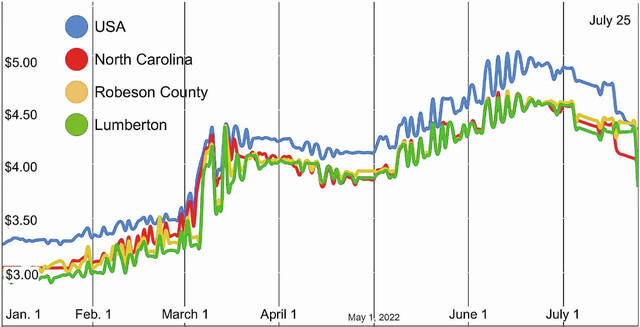
Pumpjacks around the country continue to produce oil, which will be refined into gasoline. Drivers around Robeson County, as well as the rest of the country, are finding some relief as gas prices continue to drop.
LUMBERTON — Robeson County drivers saw another week of significant price drops on gasoline.
On Monday, the average cost of a gallon of gasoline in the greater Robeson County area was $4.07, according to reports from local drivers. Even better prices were found at Lumberton area gas stations, where the average price of a gallon of gas was $3.79.
The price of gasoline hasn’t been that low since the first part of 2022, when on March 15, the average price of a gallon of gas in Lumberton was selling for $3.77.
According to AAA, the fall in prices is the result of drivers changing their driving habits.
A recent study from AAA showed that drivers are making significant changes to cope with record pump prices.
“Almost two-thirds (64%) of U.S. adults have changed their driving habits or lifestyle since March, with 23% making ‘major changes,’ according to a statement released to local media on Monday. “Drivers’ top three changes to offset high gas prices are driving less, combining errands, and reducing shopping or dining out.
Nationally, the average price of a gallon of gasoline has dropped for the last six weeks straight, falling 18 cents from a week ago to $4.32 per gallon on Monday, according to GasBuddy data compiled from more than 11 million individual price reports covering over 150,000 gas stations across the country.
In March of this year, AAA released gas survey data examining the pump prices Americans would view as too expensive. At that time, over half (59%) said they would change their driving habits or lifestyle if the cost of gas rose to $4 per gallon.
If gas were to reach $5, which it did in June, three-quarters said they would need to adjust their lifestyle to offset the spike at the pump. At that time, among Americans who said they would make changes in response to higher gas prices, a majority (80%) said they would opt to drive less. The new AAA survey reaffirms these driving habit changes.
The most recent Robesonian online poll reflects that attitude, reporting that most people (48%) said summer vacation travel was too expensive this year; 27% said vacation travel was on, but their vacation plans would be scaled back, the last 25% said they weren’t making any changes to vacation plans, but accepted that they would just spend more than planned.
National News
Last week’s report from the Energy Information Administration showed a small 400,000 barrel decline in oil inventories, while the Strategic Petroleum Reserve fell by 5 million barrels.
Total oil inventories now stand 22.7% below the year ago level as the SPR stands at its lowest level since the reserve was being filled in the 1980s.
Gasoline inventories rose 3.5 million barrels in the last week, but are down 8% from last year and are 3% lower than the five year average for this time of year.
Distillate inventories fell by 1.3 million barrels and are 20% below the year ago level while falling to a 23% deficit to the five year average for this time of year.
Implied gasoline demand rose 459,000 barrels to 8.52 million barrels per day, with year-to-date implied demand now just 0.1% higher than last year. Refinery utilization fell 1.2 percentage points to 93.7%, with gasoline production rising and distillate production falling.
Good Gas Ideas
AAA suggested that drivers practice the following to get the most out of their vehicle.
– Keep your vehicle in top shape with routine inspections and in between, make sure your tires are properly inflated. Underinflated tires are a drag on fuel economy.
– Map your route before you go to minimize unnecessary turnarounds and backtracking. Avoid peak traffic times and, if possible, go to “one-stop shops” where you can do multiple tasks (banking, shopping, etc.).
– Fuel economy peaks at around 50 mph on most cars, then drops off as speeds increase. Reducing highway speeds by 5 to 10 mph can improve fuel economy by as much as 14%.
– Only use premium gas in vehicles that recommend or require it. Paying for premium gas for a car that takes regular is a waste of money and is of no benefit to the vehicle.








